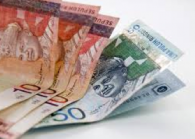
SINGAPORE (June 11): The steep fall in the Malaysian ringgit in recent months is conjuring up frightening memories of the Asian Financial Crisis in 1997-1998. Now, here’s a worrying observation from a well-respected economist who recalls the crash: the Malaysian economy isn’t in much better shape now than it was then.
“Other than running a current account surplus of 3.6% of GDP, Malaysia’s economy is not much better than where it was compared to the Asian Financial Crisis,” says Chua Hak Bin, Asean economist at Bank of America Merrill Lynch. External debt, for example, is currently 71% of GDP compared to around 44% in 2Q1997. Malaysia’s household debt is now the highest in Asia, at 88% of its GDP, “making it hard for leveraged consumers to contribute to the economy by increasing their spending”.
Malaysia’s public debt has also swelled to 55% of GDP currently, compared to just over 30% in 2Q1997. And, that’s before accounting for off-balance sheet debt such as government guarantees on its MRT infrastructure project in Selangor and Iskandar property development project in Johor.
The ringgit has depreciated by more than 6% against the US dollar since the start of the year, plagued by rising capital outflows, employment cuts and political uncertainty. The ringgit ended June 10 at 3.7354 per US dollar, rising 2% during the day.
The currency hit a nine-year low of 3.7743 on June 8, close to levels last seen during the Asian Financial Crisis. It is also the worst performing currency in Asia this year after Indonesia’s rupiah.
Malaysia’s central bank governor Zeti Akhtar Aziz responded to questions posed by Bloomberg on June 8, saying the ringgit’s depreciation was not reflective of Malaysia’s economic fundamentals and that its drop in value should be “temporary.”
In her statement, Zeti also noted that the ringgit’s weakness during the 1997-1998 crisis occurred when Malaysia was experiencing a major recession, low reserve levels, distressed financial markets and when the country’s current account of the balance of payments was in deficit. The governor went on to point out that “none of these extreme conditions are prevailing today.”
Chua of BoA says it would have been “difficult for [Zeti] to say otherwise”. The way he sees it, “Bank Negara needs to shore up confidence in the Malaysian economy since the government is not doing anything. The burden has fallen on Bank Negara to act as a backstop for the drop in the ringgit.”
Weakening economy
Yet, the ringgit might continue lurching lower. For one thing, Bank Negara may have to cut interest rates in 2H2015 to shore up the Malaysian economy. “The Malaysian economy could slow further from 1Q2015, which was supported by pre-[Goods and Services Tax] spending. Our sense is that there has been a big pull back in consumer spending after GST was implemented in April,” Chua says.
BoA is also expecting the US Federal Reserve to begin hike rates in September. “This will come as a shock to the ringgit because of Malaysia’s high external debt,” Chua says. And, with Malaysia’s foreign exchange reserves already falling, Bank Negara “will have to be a lot more sparing of its use of the reserves to defend the ringgit”, he adds.
Malaysia’s foreign exchange reserves climbed to US$106.4 billion as of the end of May, after falling to US$105.1 billion in March, the lowest level since 2010 and below the 10-year average of about US$112 billion.
Capital outflows
Tensions have also been mounting on the political front in Malaysia. Owing to the government’s poor handling of 1Malaysia Development Berhad, the heavily indebted national development fund, speculation is now rife that a leadership change may be on the cards. “Prime Minister Najib Razak’s popularity with the public is already at a low and there is a chance of a challenge to his leadership. This is causing uncertainty over 1MDB, of which Najib is also advisory board chairman, and is a contributing factor to the fall of the ringgit as investors take flight,” says Chua.
In 1Q2015, Malaysia saw some RM30 billion in portfolio and bank-related outflows compared to just RM10 billion in capital investments. “That’s three times more outflows than inflows and this flight of capital will continue in 2H2015. We think that even Malaysians are taking their money out of the country because of the falling ringgit,” Chua says.
Weak exports
Even exports are weakening despite Malaysia’s depreciating currency. In 1Q2015, liquefied natural gas (LNG) exports fell 40% year-on-year, weakened by the rising supply of LNG in the global market.
Lower oil prices have also decimated revenues and earnings of Malaysia’s Petroliam Nasional Berhad. For 1Q2015, Petronas reported a more than 39% y-o-y decline in earnings to RM11.4 billion. Petronas has said it will cut its dividend payout to RM26 billion for 2015. But Chua says it might cut its dividend below that level if oil prices fall further.
BoA is forecasting GDP growth of 4.6% for Malaysia in 2015. It expects the value of the Malaysian ringgit to depreciate further against the US dollar over the next two years, to 3.78 per US dollar by year end and falling further to 3.90 in 2016. Against the Singapore dollar, BoA sees the currency trading at 2.71 in 2015, and at 2.73 in 2016.